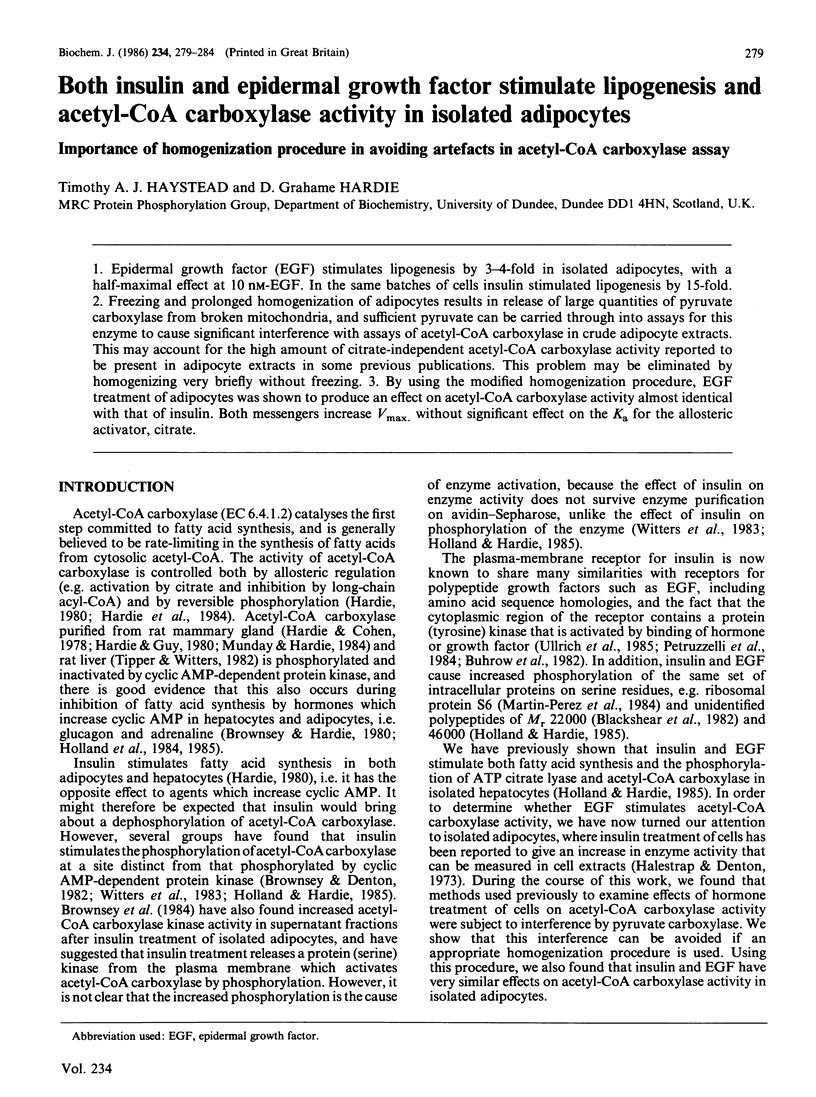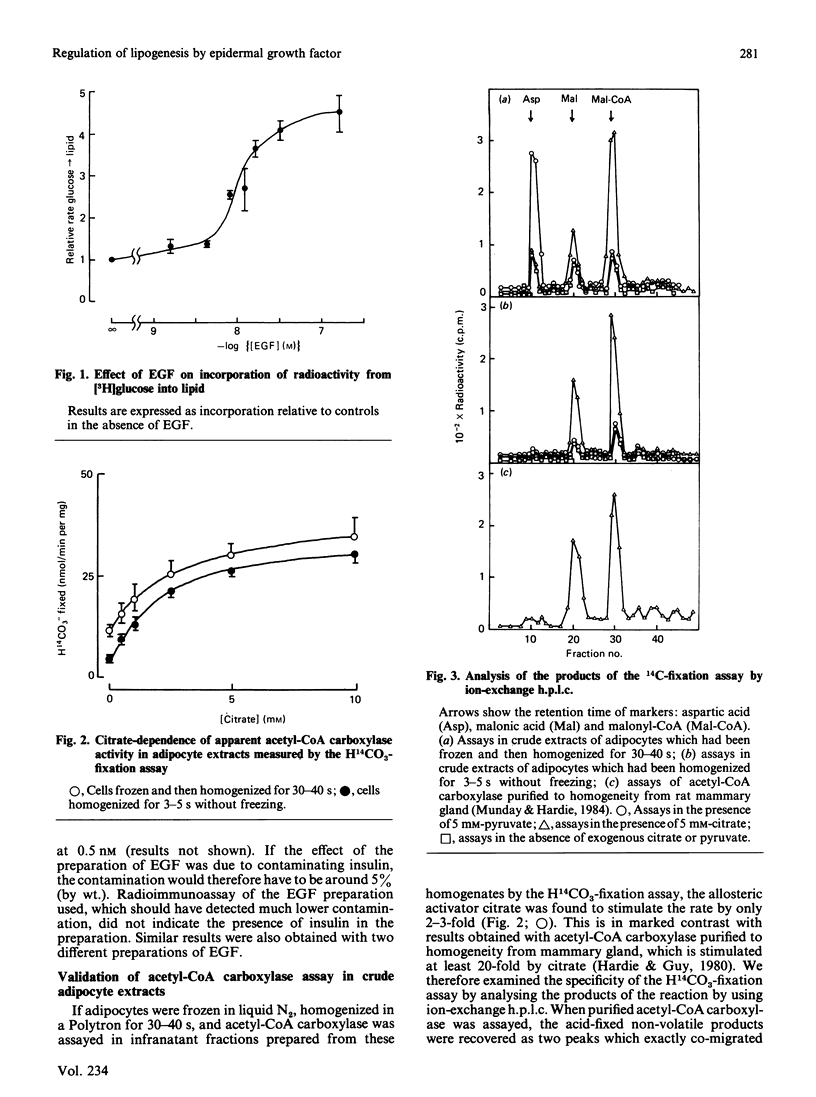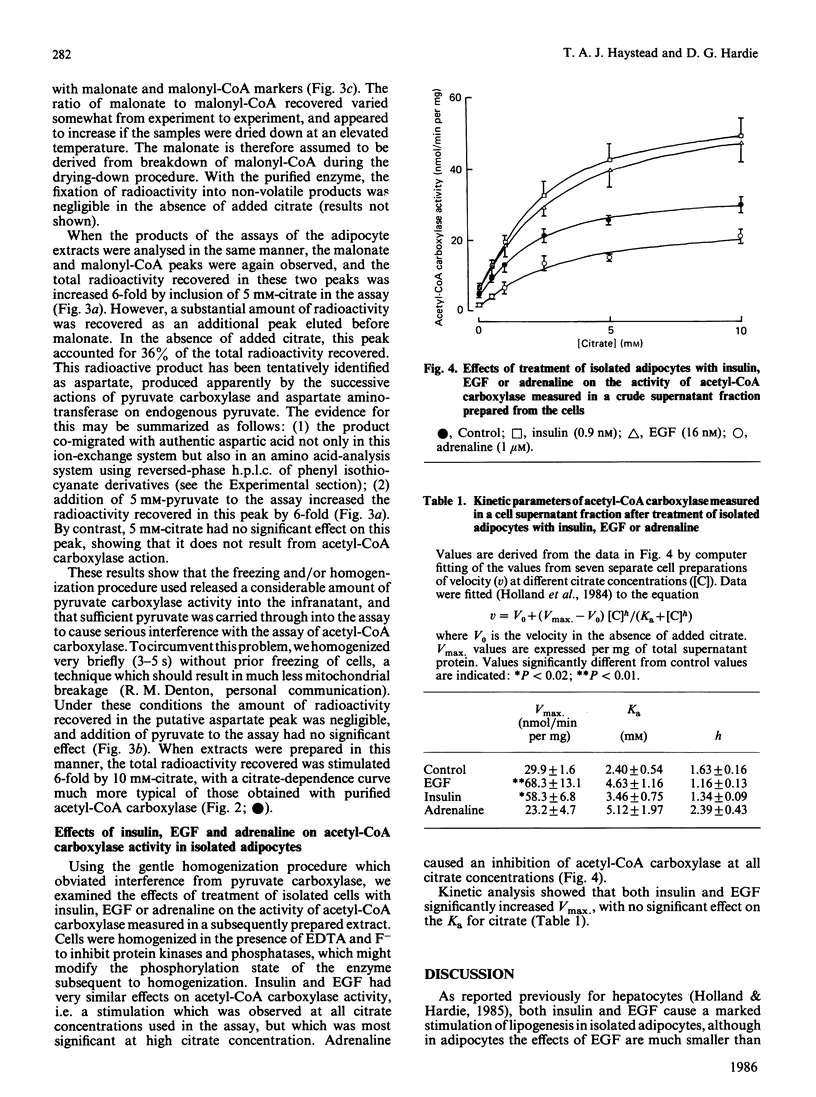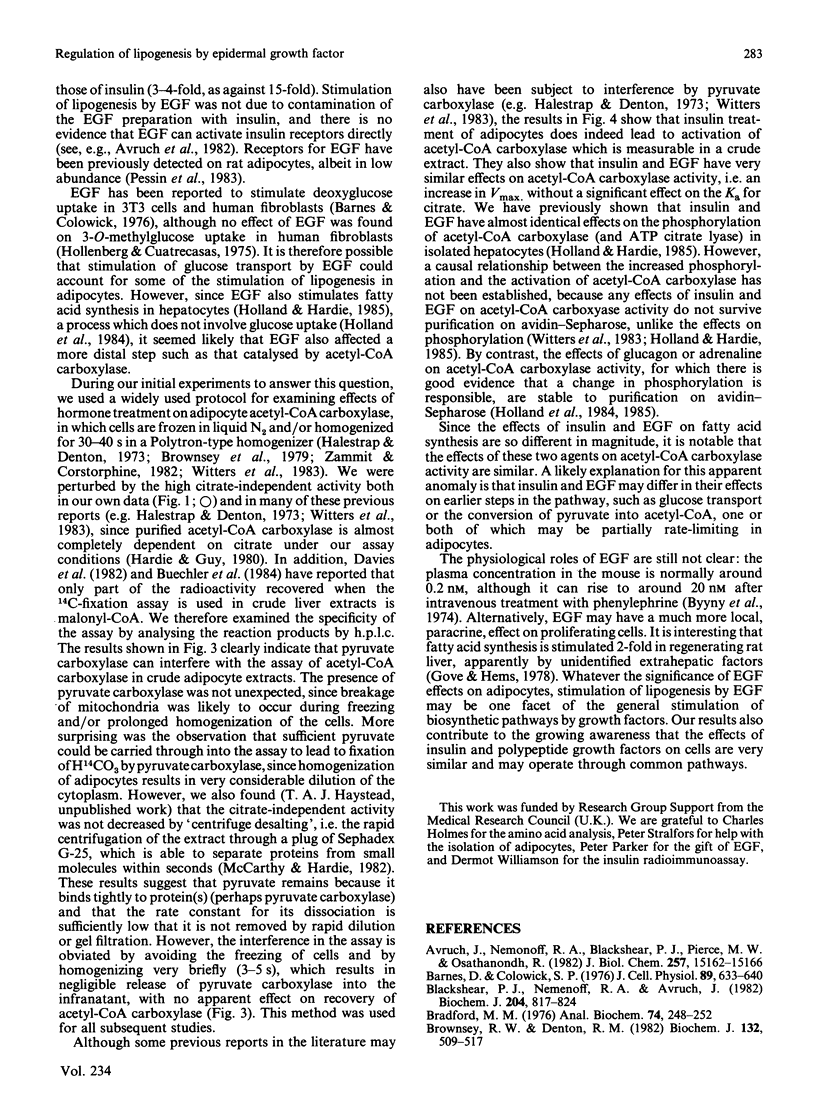Abstract
Epidermal growth factor (EGF) stimulates lipogenesis by 3-4-fold in isolated adipocytes, with a half-maximal effect at 10 nM-EGF. In the same batches of cells insulin stimulated lipogenesis by 15-fold. Freezing and prolonged homogenization of adipocytes results in release of large quantities of pyruvate carboxylase from broken mitochondria, and sufficient pyruvate can be carried through into assays for this enzyme to cause significant interference with assays of acetyl-CoA carboxylase in crude adipocyte extracts. This may account for the high amount of citrate-independent acetyl-CoA carboxylase activity reported to be present in adipocyte extracts in some previous publications. This problem may be eliminated by homogenizing very briefly without freezing. By using the modified homogenization procedure, EGF treatment of adipocytes was shown to produce an effect on acetyl-CoA carboxylase activity almost identical with that of insulin. Both messengers increase Vmax. without significant effect on the Ka for the allosteric activator, citrate.
Full text
PDF





Selected References
These references are in PubMed. This may not be the complete list of references from this article.
- Avruch J., Nemenoff R. A., Blackshear P. J., Pierce M. W., Osathanondh R. Insulin-stimulated tyrosine phosphorylation of the insulin receptor in detergent extracts of human placental membranes. Comparison to epidermal growth factor-stimulated phosphorylation. J Biol Chem. 1982 Dec 25;257(24):15162–15166. [PubMed] [Google Scholar]
- Barnes D., Colowick S. P. Stimulation of sugar uptake in cultured fibroblasts by epidermal growth factor (EGF) and EGF-binding arginine esterase. J Cell Physiol. 1976 Dec;89(4):633–639. doi: 10.1002/jcp.1040890420. [DOI] [PubMed] [Google Scholar]
- Blackshear P. J., Nemenoff R. A., Avruch J. Preliminary characterization of a heat-stable protein from rat adipose tissue whose phosphorylation is stimulated by insulin. Biochem J. 1982 Jun 15;204(3):817–824. doi: 10.1042/bj2040817. [DOI] [PMC free article] [PubMed] [Google Scholar]
- Bradford M. M. A rapid and sensitive method for the quantitation of microgram quantities of protein utilizing the principle of protein-dye binding. Anal Biochem. 1976 May 7;72:248–254. doi: 10.1016/0003-2697(76)90527-3. [DOI] [PubMed] [Google Scholar]
- Brownsey R. W., Edgell N. J., Hopkirk T. J., Denton R. M. Studies on insulin-stimulated phosphorylation of acetyl-CoA carboxylase, ATP citrate lyase and other proteins in rat epididymal adipose tissue. Evidence for activation of a cyclic AMP-independent protein kinase. Biochem J. 1984 Mar 15;218(3):733–743. doi: 10.1042/bj2180733. [DOI] [PMC free article] [PubMed] [Google Scholar]
- Brownsey R. W., Hardie D. G. Regulation of acetyl-CoA carboxylase: identity fo sites phosphorylated in intact cells treated with adrenaline and in vitro by cyclic AMP-dependent protein kinase. FEBS Lett. 1980 Oct 20;120(1):67–70. doi: 10.1016/0014-5793(80)81048-9. [DOI] [PubMed] [Google Scholar]
- Brownsey R. W., Hughes W. A., Denton R. M. Adrenaline and the regulation of acetyl-coenzyme A carboxylase in rat epididymal adipose tissue. Inactivation of the enzyme is associated with phosphorylation and can be reversed on dephosphorylation. Biochem J. 1979 Oct 15;184(1):23–32. doi: 10.1042/bj1840023. [DOI] [PMC free article] [PubMed] [Google Scholar]
- Buechler K. F., Beynen A. C., Geelen M. J. Studies on the assay, activity and sedimentation behaviour of acetyl-CoA carboxylase from isolated hepatocytes incubated with insulin or glucagon. Biochem J. 1984 Aug 1;221(3):869–874. doi: 10.1042/bj2210869. [DOI] [PMC free article] [PubMed] [Google Scholar]
- Buhrow S. A., Cohen S., Staros J. V. Affinity labeling of the protein kinase associated with the epidermal growth factor receptor in membrane vesicles from A431 cells. J Biol Chem. 1982 Apr 25;257(8):4019–4022. [PubMed] [Google Scholar]
- Byyny R. L., Orth D. N., Cohen S., Doyne E. S. Epidermal growth factor: effects of androgens and adrenergic agents. Endocrinology. 1974 Sep;95(3):776–782. doi: 10.1210/endo-95-3-776. [DOI] [PubMed] [Google Scholar]
- Davies D. R., Van Schaftingen E., Hers H. G. Interference by pyruvate carboxylase in the measurement of acetyl-CoA carboxylase in crude liver preparations. Biochem J. 1982 Feb 15;202(2):559–560. doi: 10.1042/bj2020559. [DOI] [PMC free article] [PubMed] [Google Scholar]
- Gove C. D., Hems D. A. Fatty acid synthesis in the regenerating liver of the rat. Biochem J. 1978 Jan 15;170(1):1–8. doi: 10.1042/bj1700001. [DOI] [PMC free article] [PubMed] [Google Scholar]
- Halestrap A. P., Denton R. M. Insulin and the regulation of adipose tissue acetyl-coenzyme A carboxylase. Biochem J. 1973 Mar;132(3):509–517. doi: 10.1042/bj1320509. [DOI] [PMC free article] [PubMed] [Google Scholar]
- Hardie D. G., Cohen P. The regulation of fatty acid biosynthesis: simple procedure for the purification of acetyl CoA carboxylase from lactating rabbit mammary gland, and its phosphorylation by endogenous cyclic AMP-dependent and -independent protein kinase activities. FEBS Lett. 1978 Jul 1;91(1):1–7. doi: 10.1016/0014-5793(78)80005-2. [DOI] [PubMed] [Google Scholar]
- Hardie D. G., Guy P. S. Reversible phosphorylation and inactivation of acetyl-CoA carboxylase from lactating rat mammary gland by cyclic AMP-dependent protein kinase. Eur J Biochem. 1980 Sep;110(1):167–177. doi: 10.1111/j.1432-1033.1980.tb04852.x. [DOI] [PubMed] [Google Scholar]
- Holland R., Hardie D. G. Both insulin and epidermal growth factor stimulate fatty acid synthesis and increase phosphorylation of acetyl-CoA carboxylase and ATP-citrate lyase in isolated hepatocytes. FEBS Lett. 1985 Feb 25;181(2):308–312. doi: 10.1016/0014-5793(85)80282-9. [DOI] [PubMed] [Google Scholar]
- Holland R., Hardie D. G., Clegg R. A., Zammit V. A. Evidence that glucagon-mediated inhibition of acetyl-CoA carboxylase in isolated adipocytes involves increased phosphorylation of the enzyme by cyclic AMP-dependent protein kinase. Biochem J. 1985 Feb 15;226(1):139–145. doi: 10.1042/bj2260139. [DOI] [PMC free article] [PubMed] [Google Scholar]
- Holland R., Witters L. A., Hardie D. G. Glucagon inhibits fatty acid synthesis in isolated hepatocytes via phosphorylation of acetyl-CoA carboxylase by cyclic-AMP-dependent protein kinase. Eur J Biochem. 1984 Apr 16;140(2):325–333. doi: 10.1111/j.1432-1033.1984.tb08105.x. [DOI] [PubMed] [Google Scholar]
- Hollenberg M. D., Cuatrecasas P. Insulin and epidermal growth factor. Human fibroblast receptors related to deoxyribonucleic acid synthesis and amino acid uptake. J Biol Chem. 1975 May 25;250(10):3845–3853. [PubMed] [Google Scholar]
- Martin-Pérez J., Siegmann M., Thomas G. EGF, PGF2 alpha and insulin induce the phosphorylation of identical S6 peptides in swiss mouse 3T3 cells: effect of cAMP on early sites of phosphorylation. Cell. 1984 Feb;36(2):287–294. doi: 10.1016/0092-8674(84)90222-8. [DOI] [PubMed] [Google Scholar]
- McCarthy A. D., Hardie D. G. Evidence that the acyl-O-esters are intermediates in the catalysis. The mechanism of rabbit mammary fatty acid synthase. FEBS Lett. 1982 Dec 13;150(1):181–184. doi: 10.1016/0014-5793(82)81330-6. [DOI] [PubMed] [Google Scholar]
- Pessin J. E., Gitomer W., Oka Y., Oppenheimer C. L., Czech M. P. beta-Adrenergic regulation of insulin and epidermal growth factor receptors in rat adipocytes. J Biol Chem. 1983 Jun 25;258(12):7386–7394. [PubMed] [Google Scholar]
- Petruzzelli L., Herrera R., Rosen O. M. Insulin receptor is an insulin-dependent tyrosine protein kinase: copurification of insulin-binding activity and protein kinase activity to homogeneity from human placenta. Proc Natl Acad Sci U S A. 1984 Jun;81(11):3327–3331. doi: 10.1073/pnas.81.11.3327. [DOI] [PMC free article] [PubMed] [Google Scholar]
- RODBELL M. METABOLISM OF ISOLATED FAT CELLS. I. EFFECTS OF HORMONES ON GLUCOSE METABOLISM AND LIPOLYSIS. J Biol Chem. 1964 Feb;239:375–380. [PubMed] [Google Scholar]
- Tipper J. P., Witters L. A. In vitro phosphorylation and inactivation of rat liver acetyl-CoA carboxylase purified by avidin affinity chromatography. Biochim Biophys Acta. 1982 Apr 13;715(2):162–169. doi: 10.1016/0304-4165(82)90354-3. [DOI] [PubMed] [Google Scholar]
- Ullrich A., Bell J. R., Chen E. Y., Herrera R., Petruzzelli L. M., Dull T. J., Gray A., Coussens L., Liao Y. C., Tsubokawa M. Human insulin receptor and its relationship to the tyrosine kinase family of oncogenes. 1985 Feb 28-Mar 6Nature. 313(6005):756–761. doi: 10.1038/313756a0. [DOI] [PubMed] [Google Scholar]
- Witters L. A., Tipper J. P., Bacon G. W. Stimulation of site-specific phosphorylation of acetyl coenzyme A carboxylase by insulin and epinephrine. J Biol Chem. 1983 May 10;258(9):5643–5648. [PubMed] [Google Scholar]
- Zammit V. A., Corstorphine C. G. Inhibition of acetyl-CoA carboxylase activity in isolated rat adipocytes incubated with glucagon. Interactions with the effects of insulin, adrenaline and adenosine deaminase. Biochem J. 1982 Dec 15;208(3):783–788. doi: 10.1042/bj2080783. [DOI] [PMC free article] [PubMed] [Google Scholar]


